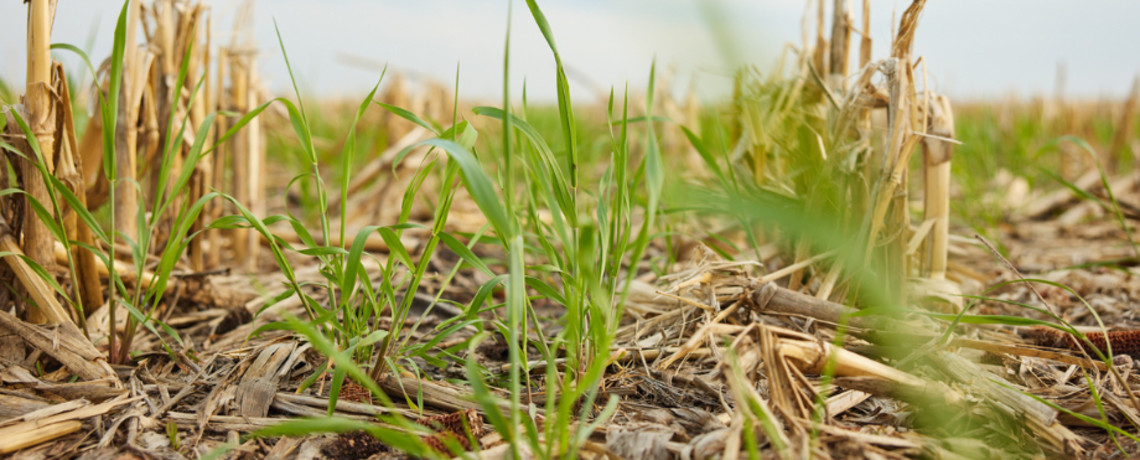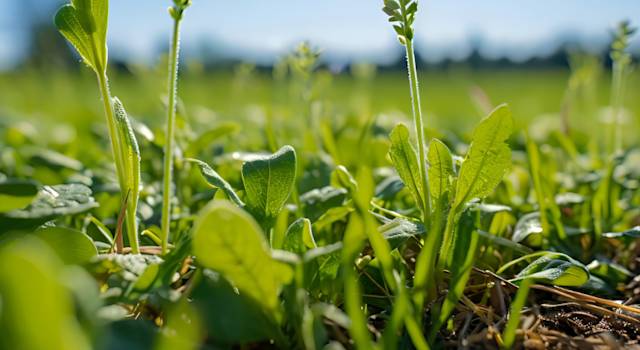
How Cover Crops and Herbicides Can Help You Control Weeds
Written by: ForGround by Bayer
Weed control can be a beast. Navigating through plant species and herbicide chemistries calls for stepped-up management, especially when herbicide-resistance or weeds with extended patterns of emergence are an issue. That’s why understanding the relationship between cover crops and herbicides can help growers keep weeds under control while also capturing soil health and erosion control benefits.
What you need to know about residual herbicides:
Residual or pre-emergence herbicides control weeds before a crop emerges from the ground. But the benefits of residual herbicide application can help build a foundation for weed control later in the growing season by remaining active in the soil.1
According to Bayer Sustainable Systems Agronomy Specialist Zach Larson, you should consider the activity level a residual herbicide might have on a cover crop species as well as its persistence in the soil. “Herbicides that are both active and persistent are the ones to worry about,” Larson explains. “Those that are short-lived or not active against the cover crop are not much of a concern.”
Residual activity is measured in the half-life of the herbicide. And that information might not be included on the product label. Larson says extension publications can be a good resource to provide information on the half-lives of common herbicides.
Rotation restrictions for some cover crops might be listed on herbicide labels. Look for information on similar crops if yours is not listed. For example, an herbicide restriction for red clover is probably applicable for all clovers. Canola can be a good substitute for radishes.
“Rotation restrictions are generally on the restrictive side,” Larson says. “Growers might experience a greater tolerance for cover crop injury from herbicide application, so herbicide restriction information from university extension can be a great resource as those are more specific to cover crops.”
How application rates affect residual efficacy and planting time for cover crops:
When application rates of residual herbicides are higher, cover crop performance can be affected. Chance of injury can be increased in higher rate situations simply because more herbicides exist in the soil.
Larson says soils with higher clay and organic matter contents typically increase crop injury risk. However, increased rainfall and warmer temperatures will likely reduce injury potential.
The presence of an acidic or alkaline pH will have herbicide-specific interactions as well, he adds.
“However, in no-till, herbicides still lose their activity as the chemicals volatize or break down from exposure to sunlight.” Larson says. How your herbicide program influences cover crop selection, seeding time and rate.
Knowing your cover crop needs and selection options is key in helping you determine the herbicide program that best fits your operation.
“If you have specific weed or crop issues that limit your herbicide options, it might be best to pick the program that works for you and adapt a cover crop system to it,” Larson explains.
When a broader list of options, easily manageable weeds and specific cover crop selection are needed to address a specific issue on your operation, selecting the cover crop before choosing a herbicide program can help ensure the two are compatible.
“Cover crops can be part of your weed control program, so as you incorporate covers, you might find that you are controlling certain weeds, changing the timing of weed emergence or shifting the species of common weeds in your system,” Larson says.
Because a one-size-fits-all seeding time and rate does not exist for planting cover crops when herbicide application takes place late in the growing season, direction comes down to specific products.
Shortening the time between herbicide application and cover crop seeding, especially with late applications, can increase the risk of crop injury. The same is true when inter-seeding cover crops into cash crops, according to Larson.
“Increasing seeding rates can help to compensate for herbicide injury,” Larson adds. “However, I suggest focusing more on species selection.”
Clovers, brassicas and other small-seeded broadleaves are generally the most susceptible species to be affected by herbicide injury. Small-seeded grasses, such as annual ryegrass, are similarly affected.
Herbicide injury is less likely to occur in larger-seeded legumes such as vetches and clovers, followed by cereal grains.
Effective weed control calls for unique plan of action:
Because your operation is unique, it requires its own weed management strategy to ensure chemistry applications align with your production protocol. Introducing cover crops requires reviewing weed management tools, especially if you are managing herbicide resistance or hard-to-control species.
Working with your local agronomist or ForGround by Bayer representative, you can gain valuable insight into the relationship between herbicides and cover crops and lessen the adoption challenges.
*This article was written by Trust In Food in collaboration with Bayer. *


